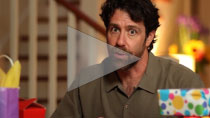From How to Shoot Video that Doesn’t Suck, Page 111:
You gotta walk before you run, and in video, you gotta learn how to compose a shot before you start waving the camera around.
Film is motion, but motion doesn’t always mean a moving camera. Moving objects in the frame, a static camera and film cuts convey enough motion and emotion to be authoritatively exciting in ways that a vaguely meandering camera won’t.
Until you’re a pro, you’ll shoot better video if you don’t move the camera. But don’t worry—a static camera doesn’t mean a boring video.
Want proof?
There are some 90 cuts in Hitchcock’s famous Psycho shower scene, and in all but four the camera stays dead still (count for yourself!) The viewer’s sense of relentless, kinetic brutality comes from the cuts between them.

Get a free preview of the new video course!
Sample two lessons from our new video course free right now. No signup or credit card required!










 Steve Stockman is a writer/ producer/ director in Los Angeles. How to Shoot Video That Doesn't Suck, available in 9 languages, is the best selling video how-to book in the world. You can find the updated edition from Workman Publishing wherever you get books, ebooks or audiobooks.
Steve Stockman is a writer/ producer/ director in Los Angeles. How to Shoot Video That Doesn't Suck, available in 9 languages, is the best selling video how-to book in the world. You can find the updated edition from Workman Publishing wherever you get books, ebooks or audiobooks. 

Steve I like the idea of your book very much and especially the rule to keep your camera still (and don’t use the zoom I may add) is very helpfull for anyone new to video filming. Just one correction: There are 50-55 cuts in the famous shower sequence. Officially 50. I counted them twice and came to 55.
Regards
Gunther
I counted a few times myself– but hey, I could be wrong. Maybe it depends on where you start. Anyone else have a thought?
You know what is even funnier about this scene? You don't see any blood on the character and we should have seen some. There is blood in the water, but none on her body or hand … yet this was still a very scary movie.
Steve, I love the concept of using the static shot as much as possible in a video. My videos, since I’ve read your book, consist of mostly static shots unless a simple movement is either motivated or can not be avoided. The static shots are sharper, simpler, and clearer to the viewer. When I try to study modern day directors who use primarily static shots, I’m hard pressed to find any. I always go back to Howard Hawks’ RedRiver, Yasujiro Ozu’s Tokyo Story, or Hitcock’s Psycho. Are there modern day directors and/or films that still utilize this method of movie-making or is it a lost art?
There’s a certain power and authority to the static shot that means they’re used a lot, although you’re right that they’re not as dominant as they were in the 30s and 40s*. (I used them a whole bunch in “Two Weeks“, for example, but better filmmakers than I use them all the time.)
The reason I talk about them in the book is not because they’re in some way better inherently, but because moving shots are easier to screw up. If you’re just learning how to compose shots and shoot really great video, it’s much easier to think about one thing– the movement in the frame. It’s like learning to drive on an automatic before tackling shifting gears. Practice storytelling without camera movement, and add it as you become a better videographer.
*Geek Note: Static shots prevailed in Hollywood during the ’30s by something of a technological accident. Silent directors moved the camera constantly. But when Hollywood started making “talkies” at the end of the ’20s, the camera noise could only be kept out of the mics by putting the cameras in, literally, a small room on the set and shooting through glass (see “Singing in the Rain” for a 1950s re-enactment– and a great film!) Later “blimps” around cameras to silence noise were still big and bulky and hard to move. It took a while to figure out how to make sound cameras small and light enough to maneuver easily.